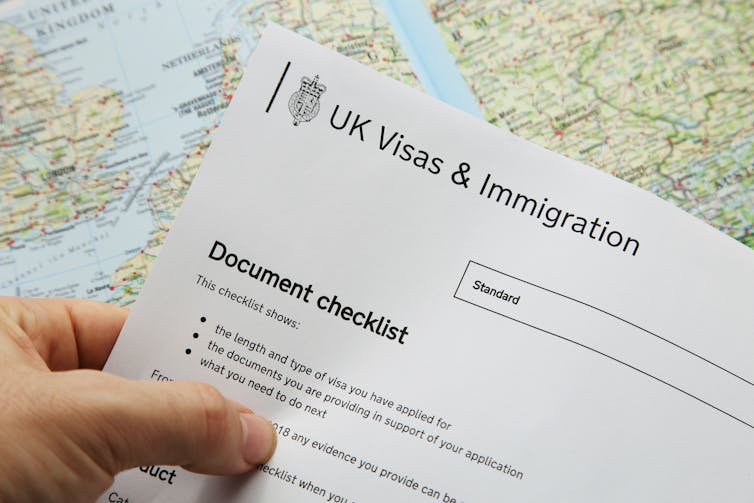Prime minister Rishi Sunak has described the UK’s new immigration figures, showing over 600,000 net migration for the year ending December 2022, as “too high”. While revised estimates from the Office for National Statistics (ONS) show this rate is actually the same as it was for the year ending June 2022, this figure is a record.
There are some obvious reasons why the numbers are up, such as “unprecedented world events throughout 2022”, as the ONS points to, and the lifting of pandemic travel restrictions. Special visa routes for people from Ukraine and Hong Kong contributed 172,000 people, and over 200,000 are international students and their dependants.
Who the figures include and exclude massively affects the total, and is, to some extent, arbitrary. For example, net migration could be reduced by a third with a simple swipe of the pen if the government did what some Conservative MPs have argued and removed international students from the figures (they tend to stay short term, and most leave at the end of their studies). People seeking asylum are now included (adding 72,000 to the total), but seasonal agricultural workers (38,000 visas in 2022) are excluded.
Regardless of how the figures are cut, the level of net migration is far higher than the “tens of thousands” promised by David Cameron, and seems set to stay that way for the foreseeable future.
Read more: Net migration: how an unreachable target came to shape Britain
It’s notable that these figures come just years after government promises to “take back control” of the UK’s borders. One of Brexit’s aims was stopping free movement from the rest of the EU. On this we can see fairly direct impacts in the latest figures, with less migration from the EU and even net outflows of European citizens.
The trade off, which immigration experts understood at the time, was that this would naturally be offset by more immigration from non-EU countries. That is exactly what has happened, although the increase has been higher than expected due to significant growth in numbers of international students and work visas.
The “new normal” may be that the work-based component of migration is around 200,000 per year, but that is open to change. Much of this is currently related to shortages in the UK labour market, for example in the NHS and social care.
So while Sunak says the numbers must come down, things are actually working more or less as intended, in the interests of UK businesses and the economy. The increased recruitment of non-EU workers is filling gaps in the labour market and bringing in fees which can run to thousands of pounds.
The gap here is a familiar one for those who follow the immigration debate – between the rhetoric of politicians around reducing immigration, and the reality of an economy which will consistently draw in new workers each year. The numbers are what you might expect compared to other countries with similar sized economies.
Quality of work
For migrants themselves, it’s a different story. The benefits of free movement were not only for UK businesses – equal rights meant better protections for EU workers who came to the UK, and the ability for labour to circulate freely.
The new system is a return to old-style visas that are costly and restrictive. They restrict worker rights – to move employers, or to have access to public services – all things that make migrants more vulnerable to exploitation. Indeed, the problems are already becoming clear in the agricultural sector where the evidence of exploitation is growing.
Commentators often accuse those who support continued immigration at the level the UK is seeing as being “addicted to cheap labour”, or avoiding the training of UK workers. But the addiction is actually to a labour market which has little or no protection for workers, and no strategy to improve standards and the quality of work. This has implications for everyone.

The post-Brexit immigration system has been constructed in a piecemeal and ad hoc fashion. While this looks like it benefits the UK economy, it is short term, further segments the labour market, criminalises informal work, and opens large numbers of people to the risks of exploitation and modern slavery.
The new illegal migration bill, following on from the Nationality and Borders Act, makes things worse by eroding what little protection had been put in place through the system to address modern slavery.
Ultimately, the lesson from previous waves of immigration is that what begins as temporary often becomes permanent, and the consequences can be long lasting. Short-term “fixes” for the labour market are not just about giving businesses what they want – they are bringing migrants, and sometimes their families, who all need and deserve equal treatment.
The kneejerk reaction this time has been to announce that international students will lose their right to bring dependants. The UK’s approach to migration has always been more about “firm” than “fair”, with a number of broken promises along the way. And the Windrush scandal has shown what happens when, in the rush to fix labour market gaps, human rights are not included in the cost-benefit analysis.
Alex Balch has received funding for research on immigration and efforts to address forced labour and human trafficking from a range of organisations including the Arts and Humanities Research Council (AHRC), Economic and Social Research Council (ESRC), Joseph Rowntree Foundation (JRF) and British Academy.
This article was originally published on The Conversation. Read the original article.







